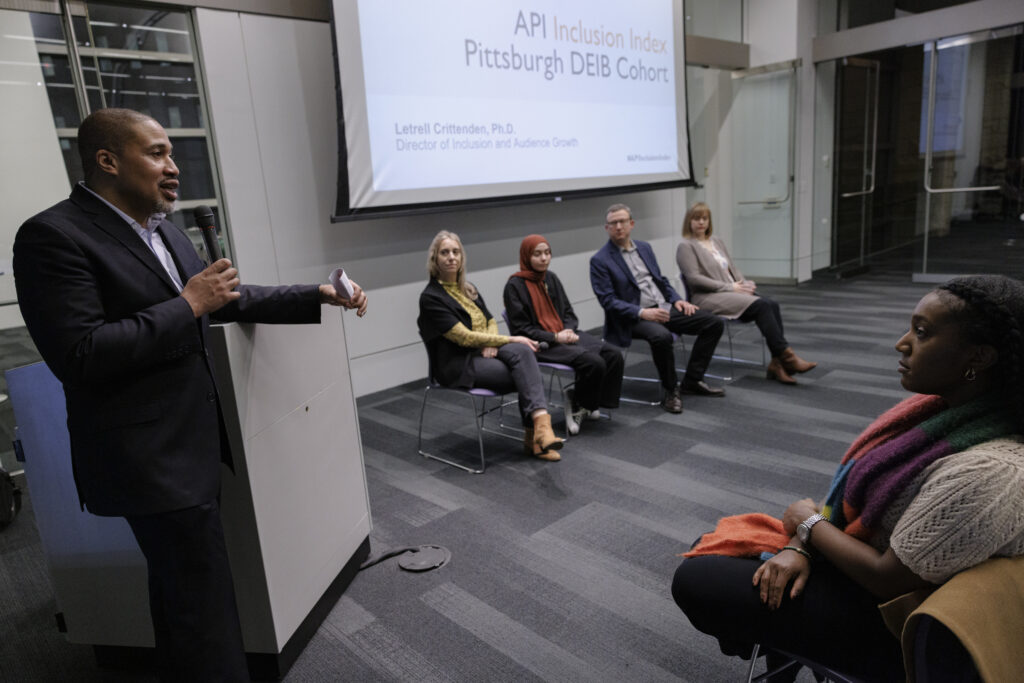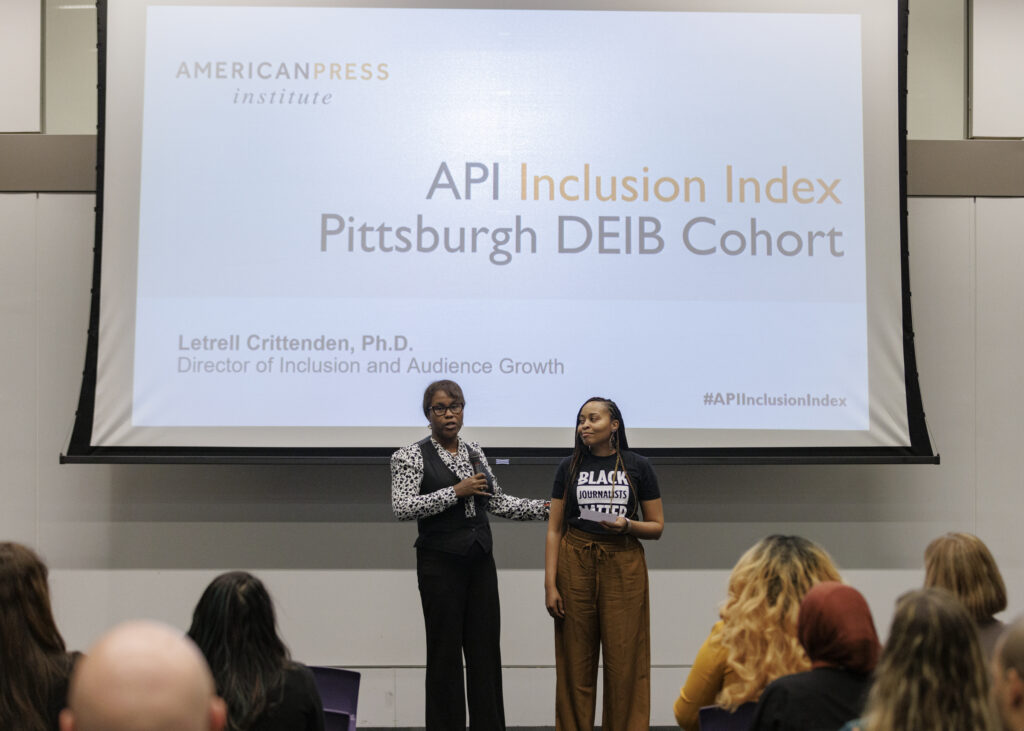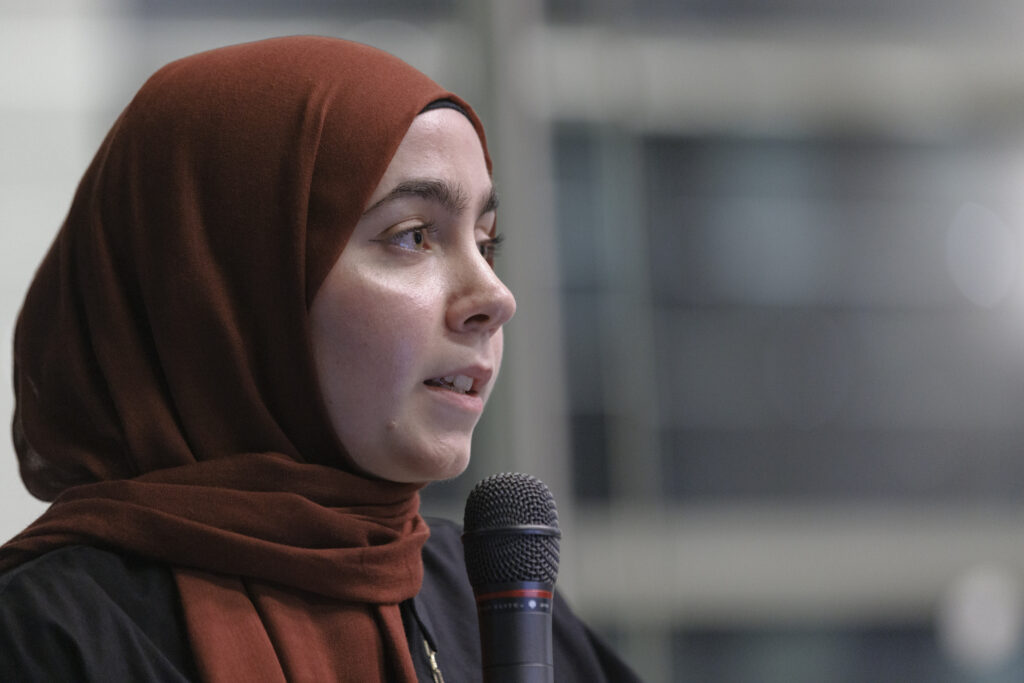Four newsrooms in Pittsburgh openly acknowledged their struggles to serve communities of color and dedicated themselves to concrete changes related to diversity and inclusion following a near-year-long project with the American Press Institute.
API’s first Inclusion Index newsroom cohort shared their respective findings and strategic plans with community members following their participation in the program. Representatives from the Pittsburgh Tribune-Review, PublicSource, Pittsburgh City Paper and The Pitt News took the floor at the August Wilson African American Cultural Center to give an overview of how they plan to implement substantive and sustainable efforts to accurately engage and cover the marginalized communities their newsrooms serve. The Pittsburgh Post-Gazette, the fifth news organization that also participated in the program, was not in attendance due to its ongoing labor dispute.
The Inclusion Index, developed and spearheaded by API Director of Inclusion and Audience Growth Letrell Deshan Crittenden, is a tool newsrooms can help newsrooms reckon with the systemic changes needed to address diversity disparities inside and out of their organizations. The Inclusion Index uncovers inequitable practices on a comprehensive scale through a targeted assessment of seven areas where possible shortfalls can impact communities of color. Its assessment is based upon research, which includes interviews with newsroom staff and community members and a content assessment. The program uses the findings to develop a report and provide recommendations on how newsrooms can sustainably move forward. (The full report can be found here. Highlights of the newsrooms’ presentations can be found below.)
“I’m so pleased that this project is happening in Pittsburgh, where with my colleagues, this is really a continuation of a lot of work that we did several years ago,” Crittenden said at the event. “But this time, we were able to really help move the needle by working directly with newsrooms and helping them find ways to better connect with communities of color — both inside and outside their newsrooms.”
Michael D. Bolden, API executive director and CEO, gave a salient reminder of why journalists do the work they do and the longstanding challenges that come with it. “We know it can seem like an insurmountable mountain, when we have problems attracting talented people into our newsrooms and keeping them there, or when people in our communities say they don’t trust us. You being here, your putting in the work is part of the process of turning it around,” Bolden said.
The Pittsburgh Black Media Federation, which helped coach newsrooms and organize community listening sessions, was a significant part of the program’s success. “As journalists who both have worked in Pittsburgh newsrooms, we know personally the value of this work extends beyond just those newsrooms. It extends to every community and every person who has a story to tell and who has someone who can connect with them in a way that is uniquely identifying to their story or to their lived experience in Pittsburgh,” said Deborah Todd, associate opinion editor at The Hill and PBMF member. “I think that’s what we’re ultimately trying to do — we’re trying to comprehensively show the face of Pittsburgh and what it is today.”
▶️ @thehill‘s @Deborahtodd, one of the program’s mentors, shared why hearing the newsroom plans was an encouraging step. #APIInclusionIndex 7/ pic.twitter.com/c3WiZbCh4w
— American Press Institute (@AmPress) February 1, 2023
The participating Pittsburgh newsrooms worked closely with consultants to develop their strategic plans, including Olga George for The Pitt News, Dr. Ervin Dyer for the Post Gazette, The Hill’s Todd for Tribune-Review and PublicSource, as well as AmyJo Brown for City Paper.
“Although this work is difficult, I felt a lot of energy.”
Dr. Ervin Dyer, a consultant for #APIInclusionIndex & member of @pghblackmedia, shared his thoughts about the work newsrooms are doing. 8/ pic.twitter.com/ViIlK6y1hz
— American Press Institute (@AmPress) February 1, 2023
Crittenden noted how although improvements have been made, diversity still needs to be addressed, especially with newsroom retention of staff of color. With regards to inclusion, newsrooms need to make more of a concerted effort with professional development and mentorship of young staff, as well as build an internal culture around mental health awareness and wellness. How newsrooms represent communities of color, especially Black communities, needs a significant overhaul, as news organizations are still publishing stories about Black people in the context of crime or sports in comparison to their other lived experiences, he said.
“Engagement is when you’re actually getting out and talking to people,” Crittenden said. “While there are some newsrooms that have moderate engagement teams that actually are dedicated to that, that’s not really something that’s happening in Pittsburgh. If you’re only trying to talk to people during the course of a story, that is extractive — you’re not building relationships.”
Crittenden noted that Pittsburgh newsrooms have been involved in numerous public controversies that have breached trust between communities of color and local media. Newsrooms also lack a full understanding of key sources within communities of color.
Overarching recommendations from the Inclusion Index report include developing impactful pipelines to training local, young talent, especially people of color; collaborating with the community, such as establishing advisory boards; and constantly assessing sources writers use in their reporting.
Following Crittenden’s summary of the report, each news organization gave attendees a rundown on why they opted to participate in the Inclusion Index, what their learnings from their assessment are and their action plans they seek to work on next. These organizations plan on sinking into the pillars of community engagement, professional development of young local talent, as well as digging deep into overhauling their respective internal culture to help staff from marginalized communities truly thrive.
“We’re really grateful that space was being made for this and that guidance was being provided. This is something we work hard to do, and we want to work harder to do, to promote empathy and understanding through our coverage,” says Halle Stockton, editor-in-chief of PublicSource, during their presentation. “That’s something that we can do as journalists while still reporting the tough issues. We want to see how we can incorporate solutions, joy and culture into the coverage of how people are navigating life in Pittsburgh.”
API’s Bolden spoke to the importance of diversity within newsrooms and how that affects their relationships with the communities they cover.
“A healthy news organization is one that values difference — that understands the power diversity has to make journalism stronger, that sees it as a valuable link for the people in the communities that surround them,” Bolden said. “Diversity is not an adjunct to other work concerns in the news industry — not when we talk of the people in our communities or the perspectives they have. It is an imperative to sustainability.”
Below are some of the highlights the newsroom presented during the event and public statements they’ve shared with their communities.
The Tribune-Review
?@TribLIVE’s Managing Editor @RobAmenTrib talked about how this cohort allowed them to have a blueprint and how they hope to progress over the next year. 10/ pic.twitter.com/zWhEMfBTMR
— American Press Institute (@AmPress) February 1, 2023
The Tribune-Review shared in their latest announcement plans to continue to “be deliberate” and commit to diversifying their staff and coverage. During their presentation, they talked about the recent launch of a diversity scholarship program for culturally diverse students who are interested in pursuing journalism, which includes a $7,500 scholarship a year, a guaranteed summer internship with the Tribune-Review and an offer for full-time employment upon graduation.Additional goals include broadening the reach and increasing the number of applicants for the scholarship program, sending reporters to engage diverse communities for features and news stories, and holding more community listening sessions across neighborhoods in Pittsburgh and surrounding areas.
The Pitt News
As an independent-run student newspaper, The Pitt News is uniquely positioned to outline the steps the University of Pittsburgh can take to address diversity disparities as a predominantly white institution. Their goals include developing a system for the community to connect with the paper, improving newsroom diversity and inclusion by cultivating a more welcoming internal culture, and ramping up recruitment efforts, collaboration and training opportunities.
PublicSource
? @PublicSourcePA‘s @tylisawrites shared her excitement for the unveiling of their plans.
Read @PublicSourcePA‘s 3-part plan to deepen connections with communities of color: https://t.co/FVSd8TUEaW #APIInclusionIndex 15/ pic.twitter.com/AvP5E72u3a
— American Press Institute (@AmPress) February 1, 2023
“If we are to do meaningful, in-depth journalism, showing the richness and fullness of our communities is critical,” PublicSource declared in its commitment to connect with communities of color. The news organization’s plans include building a map of the people and places doing impactful work, starting with the Wilkinsburg, Beechview and Perry South neighborhoods. Their other goals include building a diverse community advisory group to provide regular feedback, as well as formalizing diversity tracking of job candidates, interns and staffers.
City Paper
The City Paper’s strategic plan reflects the progress they hope to make in their commitment to improve their coverage of Pittsburgh’s diverse communities. Their three action steps include tracking data about the sources they tap for coverage, engaging directly with the community by giving staff more time in the field and capturing consistent feedback from the community, and creating a more vibrant workplace culture in the midst of their current transition of ownership and leadership.
The Pittsburgh iteration of the Inclusion Index was funded by Heinz Endowments, The Pittsburgh Foundation and Henry L. Hillman Foundation.
You might also be interested in:
Experts define moral injury as the suffering that comes from witnessing, perpetrating or failing to prevent events that violate one’s own deeply held moral beliefs and values. It is not classified as a mental illness, but it can lead to depression, substance abuse or burnout, which is one reason news managers need to understand the phenomenon of moral injury — and ways to address it or head it off.
For many newsrooms, changing the systems that protect unhealthy culture could be a few sustained decisions away from reality.
With all of the demands on a newsroom, how do you make time to build new habits in pursuit of larger goals?






